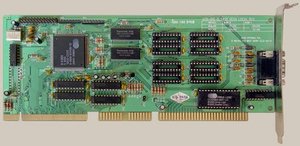VESA Local Bus
|
|
The VESA Local Bus (usually shortened to VLB) is a local bus defined by the Video Electronics Standards Association, mostly used in personal computers based on the Intel 80486 CPU. VESA Local Bus worked alongside the ISA bus; it acted as a high-speed conduit for memory-mapped I/O and DMA, while the ISA bus handled interrupts and port-mapped I/O.

The VESA Local Bus was designed as a stop-gap solution to the problem of the ISA bus's limited bandwidth. VESA had several flaws that served to limit its useful life substantially:
- 80486 dependence. The VESA Local Bus relied heavily on the 80486's memory bus design. When the Pentium processor started to gain mass acceptance, circa 1995, there were major differences in its bus design, and the VESA bus was not easily adaptable. This also made moving the bus to non-Intel architectures nearly impossible. Few Pentium motherboards with VESA slots were ever made.
- Limited number of slots available. Most PCs that used VESA Local Bus had only one or two slots available, as opposed to 5 or 6 ISA slots. This was because, as a direct branch of the 80486 memory bus, the VESA Local Bus didn't have the electrical ability to drive more than 1 or 2 (or 3 at the most) cards at a time.
- Reliability problems. The same electrical problems that limited the VESA Local Bus to 2 or 3 slots also limited its reliability. Glitches between cards were common, especially on low-end motherboards, and when important devices such as hard disk controllers were attached to the bus, there was the all-too-common possibility of massive data corruption.
Despite these problems, the VESA Local Bus was very commonplace on 486 motherboards. Probably a majority of 486-based systems had a VESA Local Bus video card, although early 486 systems never had VESA slots, as VESA debuted years after the introduction of the 486 processor.
By 1996, the Pentium (driven by Intel's Triton chipset and Peripheral Component Interconnect (PCI) architecture) had all but eliminated the 80486 market, and VESA Local Bus with it; most of the last 80486 motherboards made have PCI slots in addition to (or completely replacing) the VESA Local Bus slots.
See also
- This article was originally based on material from the Free On-line Dictionary of Computing, which is licensed under the GFDL.

